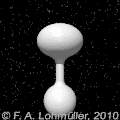Continuing from Chapter 3: Amodal Perception
Images are the primary language of the mind. We think and imagine in terms of scenes and views of objects and events that we conjure into existence and examine from different angles, testing in our mind whether this couch would fit in that corner, or whether this car would fit in that parking space. We simply will the image into existence, and we maneuver it invisibly into position in the real world, to see how much clearance there is and how tight the turns will have to be to get it there. We do this so automatically and instinctively that we are hardly aware of it, or at least aware of it as anything real, due to its amodal invisibility. But we can “see” the mental image of the couch, or car, clearly enough to estimate the clearances, sometimes assisting our mental image with sweeping motions of our hands to indicate the spatial location of the mental image as it is maneuvered into position relative to the real world. Our mind is generating 3-D images continuously in real time, both modal and amodal, in both perception and cognition. The primary function of the mind, what makes it spatially conscious, is its ability to project three-dimensional images into a spatial world of conscious experience, and that volumetric moving colored image, and the invisible amodal framework that supports it, is our only window onto the objective external world beyond the mind.
But the mental image is more than just an image. It is an image that is constructed to a particular formula that give meaning to its shape. A mental image of a cube is tied to the abstract concept of a cube, a concept that can attach to any cube as long as it is cubical. But the cube can vary in spatial location, it can rotate in orientation, it can zoom up and down in scale, it can even stretch or morph elastically (within limits) while still maintaining its perceived identity as a cube. The concept of a cube is distinct from the image of a cube, because the concept is invariant to the rotations and translations and scalings of the cube. And yet the concept is intimately connected to the image in the sense that the concept inevitably “lights up” or becomes activated in our mind whenever a cube, or cubes, are present in our experience wherever it, or they, are located. That node provides the ‘handle’ that connects imagery to language, allowing us to report verbally whether we are experiencing the image of a cube. This is the bottom-up process of visual recognition as expressed in neural network models, where the concept is represented by a “node” whose activation represents the recognition of its corresponding image in the sensory stimulus. Bottom-up recognition at least for simple shapes, exhibits an invariance to rotation, translation, and scale.
The exercise of mental imagery, or imagination, reveals that the concept is capable of more than just bottom-up recognition. It is capable of actually generating cubes in mental imagery, and it can do so through that same invariance relation. I can imagine my cube at any location, orientation, and scale, or I can imagine it rotating, translating, and scaling continuously while I am imagining it, especially if I help stabilize the image by following its corners with my fingertips as I move it through space. Mental imagery is a most extraordinary faculty that forms the foundational basis of mathematical thought. Although we have no idea how we perform this extraordinary mental calculation, we can describe the computational function of mental imagery at least in functional terms.
The most basic feature of mental imagery is the mental image space, the space of our imagination, which is extended in three dimensions, within which the images of our imagination appear. Attached to this mental image space is a conceptual representation which can be described as an abstract or symbolic code, an array of concept nodes, that represent shapes such as spheres and cubes and pyramids, invariant to their location, orientation, or scale. The computational function of mental imagery can be described as the top-down projection of an abstract spatial concept into a three-dimensional mental image through an invariance relation, assigning to the imagined object a specific location, orientation, and scale, by a deliberate act of will.
Chapter 5: Ray-Tracing Algorithms



